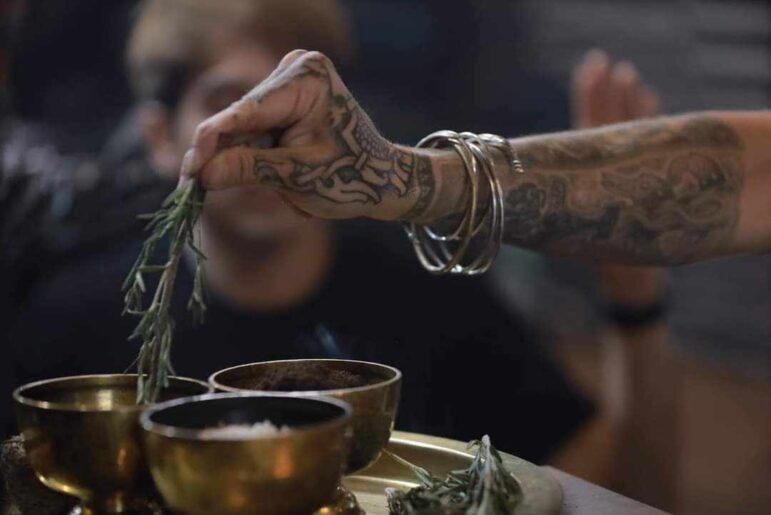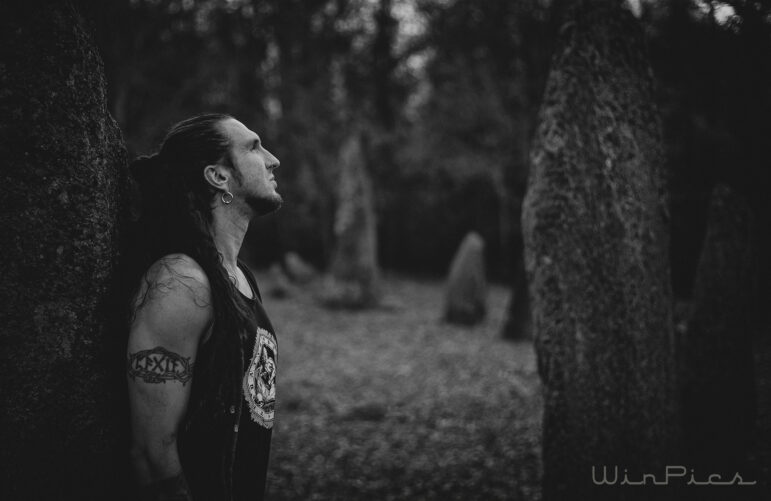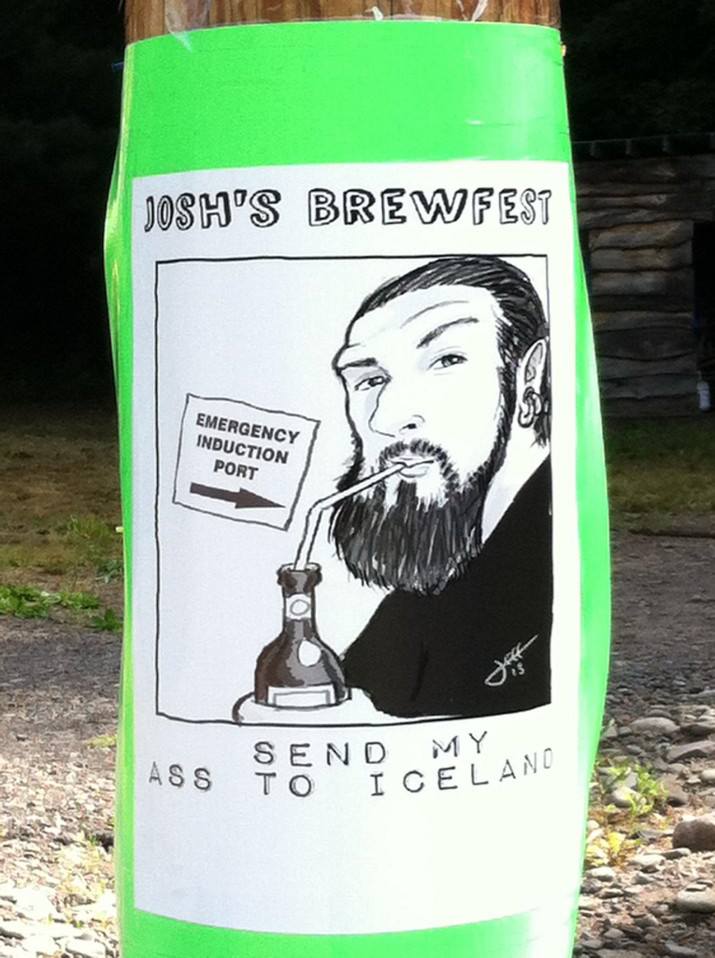
I first met Joshua Rood in the hallways of Oddi, the social science building at the University of Iceland where, like me and two other students, he was about to start an MA in Old Norse Religion. What met my sights on this day of August or September 2013 originally made me somewhat apprehensive: Here I was, recently uprooted to yet another country, to start advanced studies in a field I knew, all thing considered, very little about, and what was it that met me? A massive guy, all dressed in black, complete with heavy combat boots, a leather vest, tons of tattoos, and a mane of hair thick enough to rival a wild horse.
Had I simply been a random passerby, I probably would have been stuck with this first impression, and then forgotten all about him soon after. Thankfully, this was not the case, and as we started our academic journey under the guidance of Professor Terry Gunnell, I got to know a man of rare intelligence, boundless energy, and burning passion. Many an hour we spent crammed in various busy hallways at the university before, following the end of my MA’s first year, I moved back to Norway to work on my thesis.
Although we did not keep that much in touch in the following 10 years, I watched Joshua graduate (thanks to a fascinating thesis on the early development of the worship of Odin), get accepted for a PhD, and become an active voice in the international Heathen community. In a time where wanna-be gurus and influencers churning superficial content are a dime a dozen in the Pagan and Heathen milieus, it was only a matter of time before I realized it would be fitting for The Wild Hunt to feature a very different kind of character, someone like Joshua.
The resulting piece which you may read below (and its second part) is the result of this effort, conceived following a phone-interview in early April of this year. May it prove as educative and entertaining for the reader that it was for me to conduct.
“Well, that’s a good question!” chuckles Joshua Rood. The Upstate New York native seems somewhat taken aback by the first question I threw at him: “How should I refer to you?”
If, for some, this question could seem unnecessary, for jacks of all trades like Rood, who constantly navigates back and forth through numerous intellectual, spiritual, and artistic creative avenues, this little bit of framing can lead to some constructive reflection. After a few seconds of silent rumination, Rood settles on the following:
“I guess I can say that I am an academic researcher of Old Norse Religion in and of itself. But I also try to teach ways that it can be spiritually engaged with today, for example as a knowledge system for establishing and maintaining earth connectedness. In that way I think I try to be a voice and advocate for traditional spiritualities in general. But I don’t just teach. I perform and do ritual. I sing songs, and chant chants and I tell the sacred stories, and I offer gifts and I try to connect and teach connectedness in these ways. But I don’t really think about a title or how I should be referred to.”
Although the readers of TWH are most likely to know him for his public advocacy and teaching which he undertakes under the Eagle on the Ash, Rood has many more feathers to his cap. Not only does he conduct research on contemporary Heathen practice as a doctoral candidate in anthropology, he is also the singer and lyricist of the extreme metal band Nexion, which has played in numerous high-profile European festivals over the past few years.
Circulating freely between the academic, artistic, and spiritual worlds, Rood can be a hard man to pigeonhole, this is why I undertook to learn more about his early life and how he ended up in his current station(s).

Joshua Rood performing a ritual. Courtesy of J. Rood.
Like the majority of Pagans in North America, Joshua Rood grew up in a largely Christian environment which never truly resonated with him. Of his early spiritual experiences in Mohawk, a small, very rural region of upstate New York at the foot of the Adirondack Mountains, Rood tells a tale that is likely familiar to many: “I think it was my family’s extreme Christianity that got me so obsessed with religion and spirituality. My parents forced me to go to church and Christian Youth Group as a kid, but I never identified as Christian. But I realized early on that religion affects how we experience the world. And that means there are many ways to experience it.”
Rood soon took umbrage at the kind of evangelical Christianity he was exposed to from a very early age. He would routinely argue with youth pastors on various points of doctrine, especially that regarding the fate of those who never were exposed to the Christian gospel.
Despite growing up in a Christian environment, Rood, who also has Indigenous heritage, also recalls being exposed from an early age to Indigenous ways of thinking and spirituality: “One day my grandpa and I found a snapping turtle in the road, and he stopped the truck and we helped it to cross so it wouldn’t get hit by a car. And afterwards he told me about the woman who fell from the sky and was helped by geese onto the back of the giant turtle, and how muskrat and beaver dove down and grabbed mud for her to use as soil. This changed how I saw each of those animals from that point on.”
Rood also remembers going to Mohawk maple-tapping ceremonies as a kid where he watched how the maple trees were given gratitude for their sugar. Experiences such as these gave Rood perspective about alternative ways of comprehending and living in the world.
“I realized pretty early that different ways of thinking and believing affect how we relate to and experience the world,” he says, before mentioning the horror he once felt when hunting with a friend. After the friend’s father had killed a deer, he immediately proceeded to gut it like it was a slab of meat and not an animal.
“I wasn’t horrified that he had killed it. I grew up hunting. But my own dad would always cry, and he would always thank the deer after he shot it. There was always reverence and gratitude. Every hunt was a process of mourning and celebration. We saw it as necessary. Not a trophy or a resource,” Rood states.
“to not have those emotions or show that respect felt sociopathic and sick to me,” he continues. “So I realized not everyone experiences the world the same way as me, or my family, and that it is something deeper than belief and ethics. It’s about how you exist. I felt that this must come in part from how we are taught to exist, and that religion and spirituality, even the lack of it, plays a part in this.”
Another way Joshua Rood was exposed to non-Christian religions was school. There, as a youngster, he learned about Classical Graeco-Roman mythology, Anglo-Saxon legends such as Beowulf and more. It was also via a school project, focusing on genealogy, that he discovered that the North-European that made up much of his family heritage had not always been Christian.
This discovery led soon after to another one, namely Old Norse Religion, from where there were to be no turning back, as he recalls: “I was reading some old book about how the ancient Scandinavians worshiped trees and animals, and I think the book meant to portray it as superstitious, but I thought about how familiar it was to me from my grandpa. And I felt so sad that the old beliefs were wiped out, and that instead the Nordic side of my family was hyper Christian. I thought it was tragic. It made me angry. But I also became obsessed with learning as much about it as I could.”

Joshua Rood amidst a pre-historic ship setting site in south-eastern Norway. Pic by Espen Winther. Courtesy of J. Rood.
Rood was then 14 or 15 years old, and just starting high school. Although he had discovered a (historical) religion that appealed to him, he still had no idea that there existed modern spiritual movements that sought to reconnect with ancient faiths, but that too was soon to change. “I had a Wiccan high school teacher, we talked about various things sometimes, and I remember asking her: ‘why don’t people just start practicing these religions again?’ Which she answered saying: ‘Well, some do, or at least some try to.’”
Soon after, with the rise of internet in the late 90s and early 2000s, Rood came upon by chance upon an article showcasing the Icelandic Ásatrúarfélagið, which was then experiencing a sharp rise in membership. “It gave a stamp of affirmation to what I was doing. It told me I wasn’t alone. And it gave a name: Ásatrú.”
While these chance encounters strengthened Rood’s instinct that he had stumbled upon something worth further exploration, the soon to-be high-school graduate still had no one to share his spiritual interests with. For all he knew, he might be the only individual in the whole of the eastern seaboard who felt drawn to the Norse Gods. This however, was soon disproven.
Shortly after finishing high-school in 2004, Rood began college, working toward an eventual BA in History. “I wanted to be a historian,” he says. “I wanted to learn everything there is to know about the old Scandinavian religion, and help bring back the wisdom I felt was in it,” he continues. While in University he became involved in local Pagan student unions and clubs, but his first encounter with another person who identified as Ásatrú would be a chance encounter at a metal show.
“It’s almost cringey to think about all the stereotypes this story lumps onto me. But it was 2005 and I was down in New York City at an Amon Amarth show, of all places. I had a Mjölnir tattoo on my forearm, and a guy and a girl came up to me and pointed at my tattoo, and the guy asked if I was Asatru. I said yes, and they said that they were as well. That was the first time I met another Heathen.”
This fellow Heathen, whose name has since then been lost to the sands of time, gave Rood his and other local Heathens’ contact info. He likewise told him about the burgeoning Heathen scene of the Northeast, which, almost completely unbeknownst to Rood, had been around for over a decade. In those days, those days there was a network made up of hundreds of practitioners of Norse spirituality organized in various kindreds and blot-groups spread between Maine and Virginia.
Many if not all of the individuals involved in this Heathen-network of sorts attended each other’s events, organized gatherings, and kept touch with each other via Yahoo Groups. The most notable event that this community of sorts organized was an annual event called the East Coast Thing, held in the Poconos Mountains in Pennsylvania. “I participated in my first blot not long after that Amon Amarth concert with a well known local blot-group. Some of those people who I met at that first blot have become life-long close friends of mine, and I remember feeling very much as if I had found a community that maybe I could call my own.”
From then on, Rood started involving himself with all aspects of modern North American Heathenry. “When I started coming around I was already pretty familiar with the source material for Old Norse Religion, and I realized that there was a pretty established, I guess you could say mainstream Asatru way of doing things that just didn’t jibe with me. But that’s ok because at the same time people were always encouraging each other to learn and share what we learn, and people were experimenting with new ways of doing ritual and actively encouraging one another to develop traditions based on what we know of Old Norse Religion. I remember very well that there was this idea that Asatru is young. Our community is young. We need to learn and develop.”
“That really excited me because even though Asatru might not have been quite where I had imagined it, people were actively trying to work toward something,” Rood continues. “You don’t get temples and songs and chants and beautiful ceremonies and certainly not a deep knowledge system overnight. You need to discover and build these things. And you need a community to do it with. In that way I felt like there was space for me. I got a group of friends together and we started our own blot-group. We designed blots our own way, based on source material and what we understood of what was done and why it was done, and how we could take that information and make it relevant for ourselves. We got very experimental.”
When asked about the characteristics of the local Heathen milieu around the time when he got involved, Joshua Rood paints a portrait of a community filled with good will and enthusiasm: “Considering this was a community that practiced a fringe religion based on Nordic Belief, it was a pretty diverse network. I mean that politically, racially, ethnically, sexually, and in how they practiced Asatru. People fit a pretty wide political spectrum. But there was never tolerance for racism, and people were careful about white supremacists coming around,” he recalls.

A flyer made to support Joshua’s relocation to Iceland back in 2013. Courtesy of J. Rood.
Being entangled with various Heathen groups in the Northeast also gave Rood the opportunity to deepen his knowledge of pre-Christian Germanic religion and share that knowledge whenever possible: “I came to Asatru having never read an Asatru book. I read the Eddic material, the sagas, and as many academic articles as I could about Old Norse Religion. But I started looking into Asatru publications that people recommended, and I realized that I fundamentally disagreed with a lot of Asatru writers, and leaders. So I started researching specifically to give workshops and have discussion groups with the members of my community.”
For years Joshua Rood was known in the Northeast as a dedicated community organizer who regularly led ritual, helped arrange events, and taught his coreligionists about the ancient sources of Old Norse Religion. In 2011, he, alongside a group of like-minded Heathens, published the first volume of the Odroerir Heathen journal, where Rood published articles and took on the mantle of reviewer.
This publication was, Rood says, warmly received in the larger Heathen scene, and its success led to the publication of a second volume the following year, this time with Rood fully in charge as chief editor. One of the articles which Rood published, “Heathen: Linguistic Origins and Early Context” received particular attention even beyond the Heathen world, being, among other things, featured on the influential medievalists.net website. Upon publication, Rood also shared that paper with Professor Terry Gunnell, an authority on Old Norse Religion at the University of Iceland and the mind behind the only graduate program in the world focusing on Old Norse Religion.
At that point, Rood had already made up his mind: “I really wanted to study under Terry Gunnell. I had read everything by him I could get my hands on, really appreciated his approach, and couldn’t imagine anything more rewarding for me than to study Old Norse Religion under him.” he says. “So I was working two full time jobs for over a year,” he continues, “but even then it was not enough, so the community helped organize a fundraiser which was successful enough to make it possible for me to move to Reykjavík in the fall of 2013.”
From then on, Joshua Rood began a new chapter of his life, one characterized by the forging of new bonds, the discovery of other strands of Heathenry and an acute focus upon the academic study and communication of Old Norse Religion.
The second and final part of this interview, which will focus on Joshua Rood’s creative endeavors, academic career and advocacy, is set to be published soon here on TWH.
The Wild Hunt is not responsible for links to external content.
To join a conversation on this post:
Visit our The Wild Hunt subreddit! Point your favorite browser to https://www.reddit.com/r/The_Wild_Hunt_News/, then click “JOIN”. Make sure to click the bell, too, to be notified of new articles posted to our subreddit.